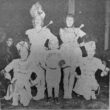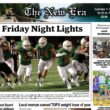My desk faces Main Street and, thanks to a couple of well-placed windows, I have a pretty good view of what’s happening out there.
Towards the end of last week, I noticed a near-parade of vehicles – RVs, pickups old and new, one rig that looked like a significantly converted school bus – all pulling trailers. Hunters headed east.
They stopped for breakfast at Apple Creek, the diner down the way from us. They stopped for gas at the Chevron station across the street. Or they rolled on through, heading for deer territory.
Hunting season is here and it’s a time for a lot of locals to celebrate the outdoors (and other things) with the annual foray into the wilderness in search, locally at least, of blacktail deer.
I didn’t grow up in a hunting family and, although I read “Fur-Fish-Game” magazines cover-to-cover as a teenager who wanted to be an outdoorsman, my career along those lines didn’t work out very well, at least until recently. I’m really a 50-some-year-old greenhorn when it comes to hunting, trying to play catch-up to people who can spot a buck’s antler tip on a hillside half a mile away while driving down the road.
But I enjoy it. I enjoy the challenge of figuring out how deer and elk live their lives and maybe some day I’ll have gained enough understanding to be able to anticipate what to expect from them out there. I think I hear guffaws, but I will say that I know more now than I did 10 years ago. That’s what makes it fun, along with just being out in the clear air on a (hopefully cold) mountainside, glassing the slopes or walking the logging roads.
But enough about me, because there really isn’t much to tell.
What I want to talk about is deer and elk populations.
This is not a new topic for any outdoorsmen or women, but I’ll remind us all anyway: deer and elk are not very plentiful. I read old copies of The New Era, which substantiate the stories I hear of hunters having lots of success in the woods around Sweet Home back in the day – 40 or 50 years ago.
Since then, a number of things have happened that haven’t been good for deer. One is a major loss of habitat. Deer need grazing and the over-growth of the Willamette National Forest due to the reduction of logging activity has resulted in thick forests with little open space. Consequently, the deer aren’t there any more. Any wildlife biologist will confirm that deer are scarce in the national forest east of Cascadia.
Another is the rise in predators, particularly cougars. Anybody who’s spent even a little time in deer territory around Sweet Home has probably come across a pile of bones and skin that was the work of a cougar. If the big cats aren’t eating our cats and dogs, they have to find something to keep them going.
Then there are vehicle casualties (probably more than we think), disease, etc.
One of those et cetra’s, though, is something that’s near and dear to the hearts of some Sweet Home residents: poaching. When I arrived in Sweet Home I was introduced to the reality that killing deer and elk out of season is common and, in some quarters, almost a golden cow.
I remember talking to one resident early on, who told me that he and many others in this community considered it a necessary part of life: take a deer to feed your family. He rhapsodized about the good old days, when folks were poor and it was not common for a widow to find a dressed deer on her porch. Our conversation taking place in the early years of the recession, he drew a parallel: Times are tough and this is what we do when we need food.
Hmmm, I sort of get that, but how about that Oregon Trail Card I see sticking out of your pocket? I had to ask, silently, if this was really about need – or was it just the fact that it’s a lot easier to shoot bucks when they’re not hidden in the brush and when you blind them with a spotlight.
(By the way, before I go any further, I need to make a disclaimer: When I began putting this column together, I had no idea Scott Staats, our outdoor writer, was going to write about poaching as well, on page 17 of todays’ paper. We’re not trying to overload you here.)
Back to my story… Soon after I arrived in Sweet Home, I was told that blacktailed deer are considered the toughest big game animal to hunt in North America. Well, I believe it – especially after hearing my wife’s relatives talk about hunting whitetails on their farms back in the Midwest. It’s not that they eat out of your hand, but there’s plenty of them and they seem a lot less concerned about their life expectancy than their local cousins.
I recall another conversation soon thereafter in which a fellow told me that there are certain barbecues that, basically, you don’t get invited to unless you took that monster elk on the sly (probably because that’s the only way you were going to get him).
It’s not just here. Several years ago a news report in the Oregonian newspaper began with the following:
“The 62-year-old retired eastern Oregon businessman admits to poaching dozens of Oregon mule deer over the past 35 years with everything from .22-caliber rifles to scope-sighted hunting rifles.
“That’s the way he grew up in the Midwest: Poaching was a rite of passage in a culture of blue-collar rural men who held down their grocery bills by illegally killing a deer now and then.
“In his view, most Oregon poachers are rural men like himself ‘who have been in the woods all their lives.’ The man, who spoke on condition that his name not be used because he could get in trouble, says he’s never gotten caught.
“But he’s tapered off considerably in recent years: He doesn’t really need the meat, and getting arrested would bring unpleasant legal consequences that he doesn’t need at this stage of his life, he says.
“But he admits: ‘It was a habit that was hard to break.’”
That story went on to cite state biologists’ findings, while conducting a mule deer distribution study in central Oregon from Bend to the California border, that the illegal take was basically equal to the legal take and most of the poachers were taking does.
One police officer quoted a poacher who told him that “Some people do cocaine. Hunting is my drug.”
Every so often we hear of poachers, sometimes single or working in groups, basically clearing a particular region of deer. And those are just the ones who get caught. With the skimpy representation of game wardens in the vast wild areas of Oregon, including the hills around Sweet Home in which, typically, there’s one Oregon State Police wildlife officer working, the chances of getting caught are slim.
But that doesn’t make it right, and that’s the point here.
I realize that there are time-honored traditions in this community, as there are everywhere. But this one doesn’t really make sense to me, other than that it might stem from the stubborn “Don’t-tell-me-what-to-do” spirit that lives here.
Resisting the law as a matter of conscience may have its place, but I find it hard to see it applied to deer hunting today.
Last year, according to Oregon Department of Fish and Wildlife statistics (which hopefully are more accurate than they used be, since hunters are now penalized if they don’t report how they did), in the McKenzie Unit, which covers all the territory around Sweet Home south of Highway 20, the deer hunting success rate was 15 percent – 739 deer among 5,001 hunters who put in a total of 32,445 days looking for bucks. Of the deer harvested, 22 percent (159) had four points or more.
In the Santiam Unit, north of Highway 20, the success rate was 13 percent – 1,030 deer among 8,055 hunters who put in 49,927 hunter days. They came home with 245 four-or-more-pointers, 23 percent.
These are, by-and-large, people who do it the right way, with rather sorry results. They buy licenses, they put in the time, and too many of them come home with nothing.
This year’s hunting forecast for the South Willamette area, which encompasses both the McKenzie and southern Santiam units, produced by ODFW, states: “Black-tailed deer populations remain below historic levels. There are still deer available but hunters need to hunt hard and smart in order to have consistent success. The bright spot is that surveys last fall indicate that post season buck ratios remain strong with an overall ratio of 27 bucks per 100 does in the district. This means there is the potential for hunters to take some mature bucks again this year.”
I hear a lot of criticism of ODFW and its management methods, much of it from people who spend a lot of time in the woods and whose opinions warrant consideration. But being a wildlife biologist is, in a sense, a no-win proposition because you’re a scientist trying to balance political interests with reality. Many have my sympathy.
We can’t control habitat, thanks to the same general forces that provide the political problems for wildlife biologists: people who are in power who don’t understand or care about what’s happening on the ground. We can’t control the vehicular toll on deer, really. We certainly can’t really control predation or disease.
But we have more ability to control poaching. Poaching is a community-based activity. A poacher generally isn’t working by himself or herself. Someone is helping to kill the deer, cut out the backstrap and hindquarters (which is common) and split, and eat it. Someone is paying for taxidermy. Someone might be selling that trophy head. Someone needs to get a conscience about this.
All you hunters who’ve put in four or five days already, doing it right, might want to reflect on this a little and talk it up. Poachers live among us. I know. One of my neighbors was one of them.
If people want a better chance of taking deer in the Sweet Home area, one thing they can do is put public pressure on those who poach.
Poachers aren’t the only ones frustrated by game laws, but the rest of us wait till the season starts. We hunt during the daylight hours. We don’t shoot deer without antlers.
The argument that poaching is a necessary part of life is simply an indication that someone’s moral compass is messed up in today’s world of plentiful aid for those truly in need – as well as those who aren’t.
Which makes the victims of poaching more than just deer.




